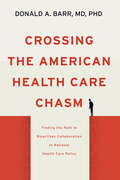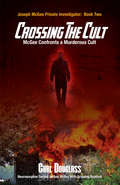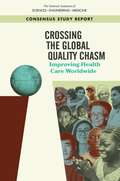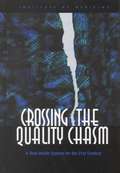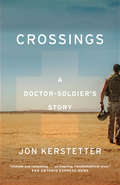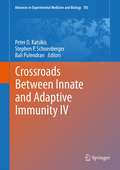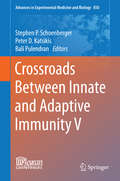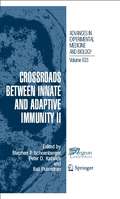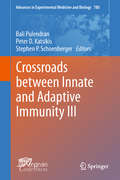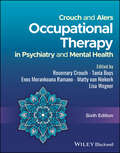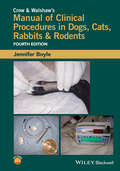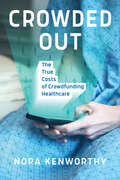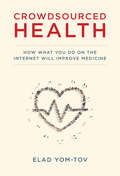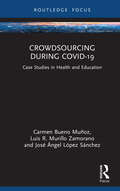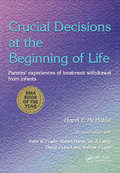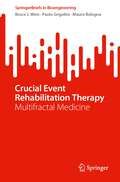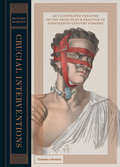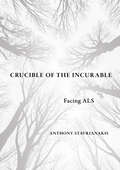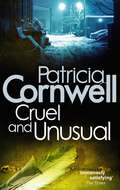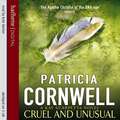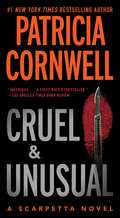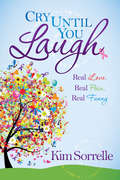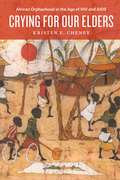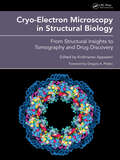- Table View
- List View
Crossing the American Health Care Chasm: Finding the Path to Bipartisan Collaboration in National Health Care Policy
by Donald A. BarrWhy is there such a deep partisan division within the United States regarding how health care should be organized and financed—and how can we encourage politicians to band together again for the good of everyone?For decades, Democratic and Republican political leaders have disagreed about the fundamental goals of American health policy. The modern-day consequences of this disagreement—particularly in the Republicans' campaign to erode the coverage and equity gains of the Affordable Care Act—can be seen in the tragic and disparate impact of COVID-19 on the country. In Crossing the American Health Care Chasm, Donald A. Barr, MD, PhD, details the breakdown in political relations in the United States. Why, he asks, has health policy—which used to be a place where the two sides could find common ground—become the nexus of fiery political conflict?From Harry S. Truman's failed attempt to enact a plan for national health insurance to the recent efforts of President Donald J. Trump, Barr's historical analysis also touches on every presidential administration in between. Tracing the bipartisanship that developed over the four decades following the passage of Medicare and Medicaid in 1965, Barr explains why this spirit of cooperation has given way to such a seemingly unbridgeable ideological chasm. Exploring how political conflict affects health care organization, financing, and delivery, Barr also offers a detailed analysis of the multiple attempts on the part of congressional Republicans and the Trump administration either to weaken or to repeal the ACA. Crossing the American Health Care Chasm offers a series of steps that policy makers can take to improve the national health care situation and provide a basis for ongoing bipartisanship as we continue to confront the policy challenges facing our country.Ultimately, Barr argues, this divide is more dangerous than ever at a time when health care costs continue to skyrocket, the number of uninsured Americans is rising, many state governments are chipping away at Medicaid, and the GOP has not let up in its efforts to dismantle the ACA. This book will be of profound interest both to those responsible for carrying out national health care policy and to those who study health policy from an academic perspective.
Crossing the Cult: McGee Confronts a Murderous Cult
by Douglass CarlCrossing the Cult is the second book of Carl Douglass's McGee series. Devon Michael Carlisle joins The Only True Church of Christ with his family when he is fifteen-years-old and lives in the bizarre polygamous world of Heart of Eden, Wyoming. The young man is a true believer, and a very bright mathematician and accountant who handles the church's accounts in New York City. For the maturing young man who begins to see the world outside the cloisters of his tight-knit religious group, a little knowledge is a dangerous thing. Devon obtains a prodigious lot of knowledge, including such things as evidence that the patriarchs of the faith have been hiding the details of their transactions in the stock market--including green mail activity and inappropriate short sales--formation of dummy corporations, and accounts in the name of church members who have no idea what transactions are taking place. The revelation for Devon is that billions of dollars are amassing in the coffers of the elite elders of The Only True Church. The evidence and Devon's concerns deepen enough for him to seek the help of McGee and Associates. That leads to Devon becoming a whistleblower; McGee's partner, Caitlin becoming an illegal hacker and forensic accountant; and the FBI launching no-knock raids on businesses. Finally Devon and his sister Ruth become defectors. Life becomes reprisals, arson, murder, and vengeance. Around the brother and sister some get rich; some get poor; and some get dead. McGee is in the vortex of the action every minute.
Crossing the Global Quality Chasm: Improving Health Care Worldwide
by Engineering Medicine National Academies of SciencesIn 2015, building on the advances of the Millennium Development Goals, the United Nations adopted Sustainable Development Goals that include an explicit commitment to achieve universal health coverage by 2030. However, enormous gaps remain between what is achievable in human health and where global health stands today, and progress has been both incomplete and unevenly distributed. In order to meet this goal, a deliberate and comprehensive effort is needed to improve the quality of health care services globally. Crossing the Global Quality Chasm: Improving Health Care Worldwide focuses on one particular shortfall in health care affecting global populations: defects in the quality of care. This study reviews the available evidence on the quality of care worldwide and makes recommendations to improve health care quality globally while expanding access to preventive and therapeutic services, with a focus in low-resource areas. Crossing the Global Quality Chasm emphasizes the organization and delivery of safe and effective care at the patient/provider interface. This study explores issues of access to services and commodities, effectiveness, safety, efficiency, and equity. Focusing on front line service delivery that can directly impact health outcomes for individuals and populations, this book will be an essential guide for key stakeholders, governments, donors, health systems, and others involved in health care.
Crossing the Quality Chasm: A New Health System for the 21st Century
by Institute of Medicine Staff Committee on Quality of Health Care in AmericaSecond in a series of publications from the Institute of Medicine's Quality of Health Care in America project Today's health care providers have more research findings and more technology available to them than ever before. Yet recent reports have raised serious doubts about the quality of health care in America. Crossing the Quality Chasm makes an urgent call for fundamental change to close the quality gap. This book recommends a sweeping redesign of the American health care system and provides overarching principles for specific direction for policymakers, health care leaders, clinicians, regulators, purchasers, and others. In this comprehensive volume the committee offers: A set of performance expectations for the 21st century health care system. A set of 10 new rules to guide patient-clinician relationships. A suggested organizing framework to better align the incentives inherent in payment and accountability with improvements in quality. Key steps to promote evidence-based practice and strengthen clinical information systems. Analyzing health care organizations as complex systems, Crossing the Quality Chasm also documents the causes of the quality gap, identifies current practices that impede quality care, and explores how systems approaches can be used to implement change.
Crossings: A Doctor-Soldier's Story
by Jon KerstetterEvery juncture in Jon Kerstetter’s life has been marked by a crossing from one world into another: from civilian to doctor to soldier; between healing and waging war; and between compassion and hatred of the enemy. When an injury led to a stroke that ended his careers as a doctor and a soldier, he faced the most difficult crossing of all, a recovery that proved as shattering as war itself.Crossings is a memoir of an improbable, powerfully drawn life, one that began in poverty on the Oneida Reservation in Wisconsin but grew by force of will to encompass a remarkable medical practice. Trained as an emergency physician, Kerstetter’s thirst for intensity led him to volunteer in war-torn Rwanda, Kosovo, and Bosnia, and to join the Army National Guard. His three tours in the Iraq War marked the height of the American struggle there. The story of his work in theater, which involved everything from saving soldiers’ lives to organizing the joint U.S.–Iraqi forensics team tasked with identifying the bodies of Saddam Hussein’s sons, is a bracing, unprecedented evocation of a doctor’s life at war.But war was only the start of Kerstetter’s struggle. The stroke he suffered upon returning from Iraq led to serious cognitive and physical disabilities. His years-long recovery, impeded by near-unbearable pain and complicated by PTSD, meant overcoming the perceived limits of his body and mind and re‑‑ imagining his own capacity for renewal and change. It led him not only to writing as a vocation but to a deeper understanding of how healing means accepting a new identity, and how that acceptance must be fought for with as much tenacity as any battlefield victory.
Crossover Designs: Testing, Estimation, and Sample Size
by Kung-Jong LuiA comprehensive and practical resource for analyses of crossover designs For ethical reasons, it is vital to keep the number of patients in a clinical trial as low as possible. As evidenced by extensive research publications, crossover design can be a useful and powerful tool to reduce the number of patients needed for a parallel group design in studying treatments for non-curable chronic diseases. This book introduces commonly-used and well-established statistical tests and estimators in epidemiology that can easily be applied to hypothesis testing and estimation of the relative treatment effect for various types of data scale in crossover designs. Models with distribution-free random effects are assumed and hence most approaches considered here are semi-parametric. The book provides clinicians and biostatisticians with the exact test procedures and exact interval estimators, which are applicable even when the number of patients in a crossover trial is small. Systematic discussion on sample size determination is also included, which will be a valuable resource for researchers involved in crossover trial design. Key features: Provides exact test procedures and interval estimators, which are especially of use in small-sample cases. Presents most test procedures and interval estimators in closed-forms, enabling readers to calculate them by use of a pocket calculator or commonly-used statistical packages. Each chapter is self-contained, allowing the book to be used a reference resource. Uses real-life examples to illustrate the practical use of test procedures and estimators Provides extensive exercises to help readers appreciate the underlying theory, learn other relevant test procedures and understand how to calculate the required sample size. Crossover Designs: Testing, Estimation and Sample Size will be a useful resource for researchers from biostatistics, as well as pharmaceutical and clinical sciences. It can also be used as a textbook or reference for graduate students studying clinical experiments.
Crossroads Between Innate and Adaptive Immunity IV (Advances in Experimental Medicine and Biology #785)
by Bali Pulendran Peter D. Katsikis Stephen P. SchoenbergerThis volume presents a collection of reviews derived from work presented at the Aegean Conference: “4th Crossroads between innate and adaptive immunity”. This meeting was the fourth in a series, and assembled a team of scientists working on mechanisms by which the innate immune system of the host senses pathogens, the cellular and signaling networks that orchestrate the innate response and antigen presentation and adaptive immunity. The importance of the crosstalk between innate immunity and the adaptive immune response has only recently started to be appreciated. Although it is well recognized that dendritic cells, NK cells, NK-T cells and T cells are all critical for the host response to pathogens, the respective fields that study the biology of these immune cells tend to exist in parallel worlds with minimum exchange of information and ideas. This fragmentation hinders the integration of these fields towards a unified theory of host response. The Aegean Conference “Crossroads between Innate and Adaptive Immunity” brought together leading international scientists and experts to address critical areas of Innate and Adaptive immunity something necessary for the development of more efficient scientific exchange and crosspollination between these fields. This conference attracted scientists from all over the world to discuss their latest findings on the various aspects of Innate and Adaptive immunity. The conference had limited participation and a scientific and social program that maximized scientific interchange through lecture presentations, poster sessions and informal discussions.
Crossroads Between Innate and Adaptive Immunity V (Advances in Experimental Medicine and Biology #850)
by Bali Pulendran Peter D. Katsikis Stephen P. SchoenbergerThis volume presents a collection of reviews derived from work presented at the Aegean Conference: “5th Crossroads Between Innate and Adaptive Immunity”. This meeting was the fifth in a series, and assembled a team of scientists working on mechanisms by which the innate immune system of the host senses pathogens, the cellular and signaling networks that orchestrate the innate response and antigen presentation and adaptive immunity. The importance of the crosstalk between innate immunity and the adaptive immune response has only recently started to be appreciated. Although it is well recognized that dendritic cells, NK cells, NK-T cells and T cells are all critical for the host response to pathogens, the respective fields that study the biology of these immune cells tend to exist in parallel worlds with minimum exchange of information and ideas. This fragmentation hinders the integration of these fields towards a unified theory of host response. The Aegean Conference “Crossroads between Innate and Adaptive Immunity” brought together leading international scientists and experts to address critical areas of Innate and Adaptive Immunity, a necessary step in the development of more efficient scientific exchange and crosspollination between these fields. This conference attracted scientists from all over the world to discuss their latest findings on the various aspects of Innate and Adaptive Immunity, and maximized scientific interchange through lecture presentations, poster sessions and informal discussions. This volume will include mini-reviews derived from work to be presented at the Aegean Conference: Second Crossroads between Innate and Adaptive Immunity, in Crete, Greece, June 17-22, 2007. This meeting is designed to serve as a forum to discuss the most recent progress in complement research as it pertains to human disease pathogenesis and therapeutics. The rapid pace of development in complement basic research and the advent and application of new experimental approaches in this field have now allowed us to take an integrated view of the in vivo biology of the complement system. The availability of new reagents (e.g. synthetic and recombinant inhibitors) and animal models (e.g. transgenic and knockout mice) has enabled us to address, in an in vivo setting, its involvement in various pathophysiological conditions. Such studies are shedding new light on the pathogenetic mechanism of complement-related diseases such as autoimmune diseases and inflammatory tissue damage as well as defining new areas of high interest such as the developmental biology of complement. They also provide the basis for developing new therapeutic strategies for these diseases through manipulation of in vivo complement activity. This volume will serve as a resource where the latest development in these specific areas will be discussed in a more focused and detailed manner.
Crossroads between Innate and Adaptive Immunity II (Advances in Experimental Medicine and Biology #633)
by Bali Pulendran Peter D. Katsikis Stephen P. SchoenbergerAegean Conferences is an independent, nonprofit, educational organization directed and managed by the scientific community. The board is made up of nine researchers/scientists in various disciplines from Harvard, Brown, University of Pennsylvania, UCSD, Princeton, Biovista and the Foundation for Biomedical Research Academy of Athens. The board both invites and approves unsolicited proposals for Conferences in all fields of Science, Engineering, Arts, and Humanities. The purpose of the Conferences is to bring together individuals with common interests to examine the emerging and most advanced aspects of their particular field. This volume will include mini-reviews derived from work to be presented at the Aegean Conference: Second Crossroads between Innate and Adaptive Immunity, in Crete, Greece, June 17-22, 2007. This meeting is designed to serve as a forum to discuss the most recent progress in complement research as it pertains to human disease pathogenesis and therapeutics. The rapid pace of development in complement basic research and the advent and application of new experimental approaches in this field have now allowed us to take an integrated view of the in vivo biology of the complement system. The availability of new reagents (e.g. synthetic and recombinant inhibitors) and animal models (e.g. transgenic and knockout mice) has enabled us to address, in an in vivo setting, its involvement in various pathophysiological conditions. Such studies are shedding new light on the pathogenetic mechanism of complement-related diseases such as autoimmune diseases and inflammatory tissue damage as well as defining new areas of high interest such as the developmental biology of complement. They also provide the basis for developing new therapeutic strategies for these diseases through manipulation of in vivo complement activity. This volume will serve as a resource where the latest development in these specific areas will be discussed in a more focused and detailed manner.
Crossroads between Innate and Adaptive Immunity III (Advances in Experimental Medicine and Biology #780)
by Bali Pulendran Peter D. Katsikis Stephen P. SchoenbergerThis volume presents a collection of reviews derived from work presented at the Aegean Conference: “3rd Crossroads between innate and adaptive immunity” which occurred during September 27 - October 2, 2009 at the Minoa Palace Conference Center in Chania, Crete, Greece. This meeting was the third in a series, and assembled a team of scientists working on mechanisms by which the innate immune system of the host senses pathogens, the cellular and signaling networks that orchestrate the innate response and antigen presentation and adaptive immunity. The various facets of the innate response, including dendritic cells, T cells, B cells, NK cells, NK-T cells and the complement cascade during the host response to pathogens and tumors is only now starting to be elucidated. The respective fields that focus on these immune cells and molecules have tended to be relatively compartmentalized, and yet emerging evidence points to the interconnectedness of these facets in coordinating the innate response, and its subsequent impact on the adaptive response. The goal of this conference was to initiate cross-talk between these diverse immunological fields, and promote and facilitate discussion on the interactions between the innate immune response and the adaptive immune response and ultimately facilitate collaboration between these areas of study. Following on the footsteps of the outstanding success of its precursors, the “3rd Crossroads between Innate and Adaptive Immunity” Aegean Conference was highly successful in bringing together and connecting scientists and experts from around the world to address critical areas of Innate and Adaptive immunity. This volume will include mini-reviews derived from work to be presented at the Aegean Conference: Second Crossroads between Innate and Adaptive Immunity, in Crete, Greece, June 17-22, 2007. This meeting is designed to serve as a forum to discuss the most recent progress in complement research as it pertains to human disease pathogenesis and therapeutics. The rapid pace of development in complement basic research and the advent and application of new experimental approaches in this field have now allowed us to take an integrated view of the in vivo biology of the complement system. The availability of new reagents (e.g. synthetic and recombinant inhibitors) and animal models (e.g. transgenic and knockout mice) has enabled us to address, in an in vivo setting, its involvement in various pathophysiological conditions. Such studies are shedding new light on the pathogenetic mechanism of complement-related diseases such as autoimmune diseases and inflammatory tissue damage as well as defining new areas of high interest such as the developmental biology of complement. They also provide the basis for developing new therapeutic strategies for these diseases through manipulation of in vivo complement activity. This volume will serve as a resource where the latest development in these specific areas will be discussed in a more focused and detailed manner.
Crouch and Alers Occupational Therapy in Psychiatry and Mental Health
by Rosemary CrouchCelebrating its evolution over thirty-four years, the sixth edition of Crouch and Alers Occupational Therapy in Psychiatry and Mental Health continues its legacy as a trailblazing guide, reshaped to address the challenges of a post-Covid, globalised world. Led by renowned expert Rosemary Crouch, this edition embraces an inclusive perspective on human functionality, social inclusion, and participation in everyday life. Highlighting the pressing need for occupational therapy’s role in addressing the burden of mental health disorders, it forecasts the staggering economic impact and emphasises prevention, resilience-building, and adaptive participation in daily activities. Featuring thirty interconnected chapters by seasoned practitioners and academics, this book: Aligns with international mental health standards and sustainable development policies, emphasising universal health access and human rightsCovers key aspects of occupational therapy, exploring theoretical perspectives for mental health care practice, ethical considerations and cultural sensitivity, advocating for occupational justice, and breaking barriers in mental health careIntroduces case studies and reflective questions at the end of each chapter to foster the integration of theory with practical application for different age groupsReflects upon emerging trends such as human ecosystem disruptions, spirituality and mental health, the impact of trauma on individuals and collectives, and maternal mental health concerns Crouch and Alers Occupational Therapy in Psychiatry and Mental Health is ideal for occupational therapy students and newly qualified practitioners, as well as any health professional looking for an up-to-date, evidence-based resource on this aspect of mental health care.
Crow and Walshaw's Manual of Clinical Procedures in Dogs, Cats, Rabbits and Rodents
by Jennifer BoyleCrow & Walshaw's Manual of Clinical Procedures in Dogs, Cats, Rabbits, & Rodents, Fourth Edition provides practical, up-to-date information on common veterinary procedures for gerbils, hamsters, guinea pigs, dogs, cats and rabbits with detailed line drawings and photographs that demonstrate not only pertinent anatomical relationships, but also operational motions. A classic veterinary clinical manual Provides practical, up-to-date information on common veterinary procedures Detailed line drawings and photographs demonstrate pertinent anatomical relationships and operational motions Companion website offering interactive multiple choice questions and answers, and images from the text in PowerPoint
Crowded Out: The True Costs of Crowdfunding Healthcare
by Nora KenworthyAn eye-opening investigation into charitable crowdfunding for healthcare in the United States—and the consequences of allowing health care access to be decided by the digital crowd.Over the past decade, charitable crowdfunding has exploded in popularity across the globe. Sites such as GoFundMe, which now boasts a &“global community of over 100 million&” users, have transformed the ways we seek and offer help. When faced with crises—especially medical ones—Americans are turning to online platforms that promise to connect them to the charity of the crowd. What does this new phenomenon reveal about the changing ways we seek and provide healthcare? In Crowded Out, Nora Kenworthy examines how charitable crowdfunding so quickly overtook public life, where it is taking us, and who gets left behind by this new platformed economy.Although crowdfunding has become ubiquitous in our lives, it is often misunderstood: rather than a friendly free market &“powered by the kindness&” of strangers, crowdfunding is powerfully reinforcing inequalities and changing the way Americans think about and access healthcare. Drawing on extensive research and rich storytelling, Crowded Out demonstrates how crowdfunding for health is fueled by—and further reinforces—financial and moral &“toxicities&” in market-based healthcare systems. It offers a unique and distressing look beneath the surface of some of the most popular charitable platforms and helps to foster thoughtful discussions of how we can better respond to healthcare crises both small and large.
Crowdsourced Health: How What You Do on the Internet Will Improve Medicine
by Elad Yom-TovHow data from our health-related Internet searches can lead to discoveries about diseases and symptoms and help patients deal with diagnoses. Most of us have gone online to search for information about health. What are the symptoms of a migraine? How effective is this drug? Where can I find more resources for cancer patients? Could I have an STD? Am I fat? A Pew survey reports more than 80 percent of American Internet users have logged on to ask questions like these. But what if the digital traces left by our searches could show doctors and medical researchers something new and interesting? What if the data generated by our searches could reveal information about health that would be difficult to gather in other ways? In this book, Elad Yom-Tov argues that Internet data could change the way medical research is done, supplementing traditional tools to provide insights not otherwise available. He describes how studies of Internet searches have, among other things, already helped researchers track to side effects of prescription drugs, to understand the information needs of cancer patients and their families, and to recognize some of the causes of anorexia. Yom-Tov shows that the information collected can benefit humanity without sacrificing individual privacy. He explains why people go to the Internet with health questions; for one thing, it seems to be a safe place to ask anonymously about such matters as obesity, sex, and pregnancy. He describes in detrimental effects of “pro-anorexia” online content; tells how computer scientists can scour search engine data to improve public health by, for example, identifying risk factors for disease and centers of contagion; and tells how analyses of how people deal with upsetting diagnoses help doctors to treat patients and patients to understand their conditions.
Crowdsourcing during COVID-19: Case Studies in Health and Education
by Carmen Bueno Muñoz Luis R Murillo Zamorano José Ángel López SánchezCrowdsourcing is a means by which public interest is sought and leveraged to achieve specific goals, and this fascinating study highlights how the model has been used to challenge the effects of the COVID-19 pandemic. The book investigates what factors have encouraged the use of crowdsourcing during the pandemic, as well as those issues which have restricted its use. It is illustrated with four detailed case studies, covering the fields of education and health, demonstrating how crowdsourcing as a means of crisis management has, ultimately, been used to influence and develop public policy. A timely analysis of this emerging concept, the book will appeal to researchers and practitioners across health and social care, public policy and management, and the voluntary sector more generally.
Crucial Decisions at the Beginning of Life: Parents' Experiences of Treatment Withdrawl from Infants
by Hazel McHaffieThe management function is practice-based primary care and who performs it varies by practice. While the number of practice managers increase and their role continues to unfold in response to NHS changes, the development of practice management as a profession is contained if not constrained by GPs, as both employers and as the dominant profession within primary care. This stimulating review of the responsibilities, opportunities and future prospects of management in primary care, based on workshops with GPs and practice managers, identifies their respective management development needs and the ways in which these might be met.
Crucial Event Rehabilitation Therapy: Multifractal Medicine (SpringerBriefs in Bioengineering)
by Mauro Bologna Bruce J. West Paolo GrigoliniThis book describes a new strategy for rehabilitation from injury and/or disease using Crucial Event Therapy. Recent studies have shown that individuals can recuperate more rapidly from surgery and other invasive procedures intended to correct the negative effects of disease or injury through the use of life support systems that operate at the body's natural biofrequencies. The same observation has been clinically shown to reverse the degenerative effects of neurodegenerative diseases such as Parkinson’s and Alzheimer's Disease. Crucial Event Therapy describes medicine as the operational control of the functions of the human body treated as a network-of-networks, with 1/f-variable crucial events coding the dynamic states of health and disease through information flow within a network and information exchange between biomedical networks. A new way of thinking based on the statistics of Cortical Events is presented and the relevant literature is suitably referenced. This is an ideal book for biophysicists and data scientists seeking to understand the connection of complexity measures for the study of consciousness with the clinical aspects of designing a rehabilitation strategy.
Crucial Interventions: An Illustrated Treatise On The Principles And Practice Of Nineteenth-century Surgery
by Richard BarnettA beautifully illustrated look at the evolution of surgery, as revealed through rare technical illustrations, sketches, and oil paintings The nineteenth century saw major advances in the practice of surgery. In 1750, the anatomist John Hunter described it as “a humiliating spectacle of the futility of science”; yet, over the next 150 years the feared, practical men of medicine benefited from a revolution in scientific progress and the increased availability of instructional textbooks. Anesthesia and antisepsis were introduced. Newly established medical schools improved surgeons’ understanding of the human body. For the first time, surgical techniques were refined, illustrated in color, and disseminated on the printed page. Crucial Interventions follows this evolution, drawing from magnificent examples of rare surgical textbooks from the mid-nineteenth century. Graphic and sometimes unnerving yet beautifully rendered, these fascinating illustrations, acquired from the Wellcome Collection’s extensive archives, include step-by-step surgical techniques paired with depictions of medical instruments and depictions of operations in progress. Arranged for the layman (from head to toe) Crucial Interventions is a captivating look at the early history of one of the world’s most mysterious and macabre professions.
Crucible of the Incurable: Facing ALS (Expertise: Cultures and Technologies of Knowledge)
by Anthony StavrianakisCrucible of the Incurable concerns how people face life with amyotrophic lateral sclerosis (ALS). Anthony Stavrianakis spent a year in clinics and with people living with the illness in the United States. He examines the multiple meanings of care in a context of a chronic, degenerative, one-hundred percent fatal, neuromuscular illness, whose most common duration is between two and five years. How do people diagnosed with ALS continue to "live as well as possible, for as long as possible" in accordance with the normative work at the heart of outpatient ALS care? Crucible of the Incurable shows how those touched by the situation of a person living with ALS bear this problem and this task. Given the sense of certitude around the diagnosis, given past experiences of those aware of its usual progression, and given the uncertainty of the disease's cause and its progression for each specific person; how then do people orient themselves to the experience of life with this illness, how to support those who are confronted with it, and how to provide aid or solace.
Cruel And Unusual (Kay Scarpetta #4)
by Patricia CornwellThe fourth book in the Kay Scarpetta series, from No. 1 bestselling author Patricia Cornwell.'America's most chilling writer of crime fiction' The TimesThe fingerprints say the murderer is the man who's just been executed . . .At 11.05 one December evening in Richmond, Virginia, convicted murderer Ronnie Joe Waddell is pronounced dead in the electric chair. At the morgue Dr Kay Scarpetta waits for Waddell's body. Preparing to perform a post-mortem before the subject is dead is a strange feeling, but Scarpetta has been here before. And Waddell's death is not the only newsworthy event on this freezing night: the grotesquely wounded body of a young boy is found propped against a rubbish skip. To Scarpetta the two cases seem unrelated, until she recalls that the body of Waddell's victim had been arranged in a strikingly similar position . . .Praise for the groundbreaking series: 'One of the best crime writers writing today' Guardian 'Devilishly clever' Sunday Times 'The top gun in this field' Daily Telegraph 'Forget the pretenders. Cornwell reigns' Mirror 'The Agatha Christie of the DNA age' Express
Cruel And Unusual (Kay Scarpetta)
by Patricia CornwellWhen convicted killer Ronnie Joe Waddell is executed in Virginia's electric chair, he becomes what should be a routine case for Chief Medical Examiner Kay Scarpetta. But after Waddell's execution, everyone connected to him begins to die - including a member of Scarpetta's staff. When crucial records disappear from her files, Scarpetta comes under fire for incomeptence. Caught in a web of political intrigue, she must fight to free herself from murderous insinuations and threats to her own life. She soon finds herself retracing Waddell's bloody footprints, following a trail that might lead to long-hidden secrets deep within the state government. Either the truth will set her free - or unleash upon her a punishment both cruel and unusual.
Cruel and Unusual: Scarpetta 4 (The Scarpetta Series #4)
by Patricia CornwellThe inspiration for the Prime Video series Scarpetta—starring Nicole Kidman and Jamie Lee Curtis! &“A knockout&” (People) of a thriller from #1 New York Times bestselling author Patricia Cornwell featuring medical examiner Kay Scarpetta.“Killing me won’t kill the beast” are the last words of rapist-murderer Ronnie Joe Waddell, written four days before his execution. But they can’t explain how medical examiner Dr. Kay Scarpetta finds Waddell’s fingerprints on another crime scene—after she’d performed his autopsy. If this is some sort of game, Scarpetta seems to be the target. And if the next victim is someone she knows, the punishment will be cruel and unusual...
Cry Until You Laugh: Real Love, Real Pain, Real Funny
by Kim SorrelleThere are so many things that we do not have control over, things that we would not ever choose: cancer, loosing a spouse, tragic accidents. But we can choose how we will handle these things. Joy is a choice that anyone can make but not everyone knows how. Facing cancer, becoming a widow, loosing the future as the author saw it made her recognize that she had to choose a way to deal with the present.
Crying for Our Elders: African Orphanhood in the Age of HIV and AIDS
by Kristen E. CheneyThe HIV/AIDS epidemic in Africa has defined the childhoods of an entire generation. Over the past twenty years, international NGOs and charities have devoted immense attention to the millions of African children orphaned by the disease. But in Crying for Our Elders, anthropologist Kristen E. Cheney argues that these humanitarian groups have misread the ‘orphan crisis’. She explains how the global humanitarian focus on orphanhood often elides the social and political circumstances that actually present the greatest adversity to vulnerable children—in effect deepening the crisis and thereby affecting children’s lives as irrevocably as HIV/AIDS itself. Through ethnographic fieldwork and collaborative research with children in Uganda, Cheney traces how the “best interest” principle that governs children’s’ rights can stigmatize orphans and leave children in the post-antiretroviral era even more vulnerable to exploitation. She details the dramatic effects this has on traditional family support and child protection and stresses child empowerment over pity. Crying for Our Elders advances current discussions on humanitarianism, children’s studies, orphanhood, and kinship. By exploring the unique experience of AIDS orphanhood through the eyes of children, caregivers, and policymakers, Cheney shows that despite the extreme challenges of growing up in the era of HIV/AIDS, the post-ARV generation still holds out hope for the future.
Cryo-Electron Microscopy in Structural Biology: From Structural Insights to Tomography and Drug Discovery
by Krishnarao AppasaniCryo-electron microscopy, in combination with tomography, has emerged as a new technology for visualizing molecular structures at a resolution beyond even 1 Å. Using this technology has revealed the native molecular details of viruses, membranes, enzymes, ribosomes, and cells. This comprehensive volume brings together authoritative overviews of these methods from structural and biological perspectives. It is a must-have for researchers and graduate students, as well as those working in industry, primarily in the areas of biophysics, structural biology, crystallography, and genomics.Key Features• Focuses on the applications of cryo-EM to structural biology• Documents the importance of cryo-EM/ET approaches in studying the structural determinants of cellular organelle and membrane protein biochemistry• Reviews the applications of high-resolution structures of viruses• Emphasizes structural insights of nuclear and gene machineries• Includes a section focused entirely on the applications of cryo-EM/ET in drug discovery and therapeutic development
